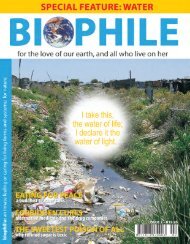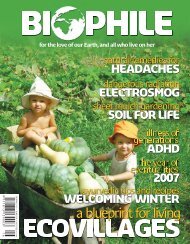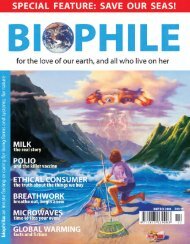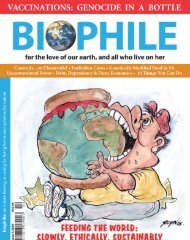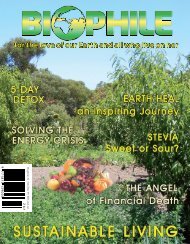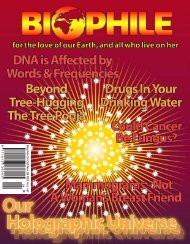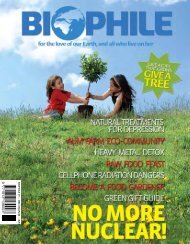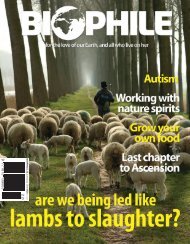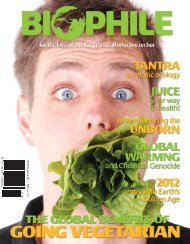the b<strong>io</strong>f<strong>ile</strong>s news from around our worldA better way tomake b<strong>io</strong>dieselScientists at the Indian Instituteof Chemical Technology havefound a much better way tomake b<strong>io</strong>diesel. Their newmethod could lower the cost andincrease the energy efficiency offuel product<strong>io</strong>n.Instead of mixing the ingredientsand heating them forhours, the chemical engineerspass sunflower oil and methanolthrough a bed of pellets madefrom fungal spores. An enzymeproduced by the fungus does thework -- making b<strong>io</strong>diesel withimpressive efficiency.Typically, b<strong>io</strong>diesel is made bymixing methanol with lye andvegetable oil and then heatingthe brew for several hours. Thisbonds the methanol to the oilsto produce energetic moleculescalled esters. Unfortunately,heating the mixture is a hugewaste of energy, and a majorselling point of alternative fuelsis efficiency. [Wired]Large scale solar plants have abright futureChina's first nat<strong>io</strong>nalpark establishedThe Nature Conservancyhas helped China achieve aconservat<strong>io</strong>n landmark: theestablishment of that country'sfirst nat<strong>io</strong>nal park, which willalso serve as a model for a newChinese nat<strong>io</strong>nal park system.The new park — Pudacuo Nat<strong>io</strong>nalPark in China's NorthwestYunnan Province — is locatedin one of the most b<strong>io</strong>diversereg<strong>io</strong>ns of the world. Wh<strong>ile</strong> thereg<strong>io</strong>n comprises only 0.7% ofChina's land area, it containsmore than 20% of the country’splant species, about one-thirdof its mammal and bird speciesand almost 100 endangered species.[RLDC]Life Responds ToYour OutlookLife is largely a matter ofexpectat<strong>io</strong>n. You mustexpect to succeed, if youwant to succeed.Expectat<strong>io</strong>n energizesyour goals and give themmomentum. [Daily Guru]Personal, portable windmillWind power is one of the most promising sources of renewableenergy, yet most often its presence is felt only on the industrialscale, in large wind farms connected to the power grid. Howgreat would it be for individuals to be able to power their devicesthrough their own personal, portable windmill? Thats the conceptbehind the ‘Wing’ Personal Windmill. The name alone has an airof freedom and mobility, and that’s exactly what this lightweightpersonal windmill creates. Portable, easily folded and carried bya single individual, Wing produces enough electricity to satisfythe primary needs of the mob<strong>ile</strong> individual; powering cell <strong>ph</strong>ones,laptops, and lamps.Designed by Ines Vlahović and Mladen Orešić of Croatia, theoriginal impetus for Wing was to provide energy in remote locat<strong>io</strong>ns(camping, at the beach, in remote rural areas, etc), but thesuccess of the prototype makes it easy to use Wing as a secondarysource of electricity in the home as well. Wing is suitable as asecondary power source in any settled situat<strong>io</strong>n, and earned oneof the highly-coveted INDEX Awards of 2007: Design to ImproveLife. [www.indexaward.dk]The Brazilian government stands accused ofselling off huge swaths of the Amazon rainforest— including its oldest protected nat<strong>io</strong>nalpark — to unscrupulous logging companies,under the cover of a flawed sustainable developmentproject.An eight-month investigat<strong>io</strong>n by Greenpeaceinto the land scam, revealed that the Brazilianland reform agency, INCRA, had set up large settlementsin rainforest areas instead of placingthem in already deforested areas, and settlingurban families who promptly sold logging rightsto major timber conpanies."Instead of helping, the official efforts are puttingin place mechanisms to ensure the supply oftimber to loggers. This opens the door to furtherforest destruct<strong>io</strong>n and climate change," saysGreenpeace's André Muggiati.Wind turbines to createpositive energyEskom’s planned wind turbineson the West Coast representSouth Africa’s first major investmentin clean, renewable energy.Eskom is planning to go “fullsteam ahead” with the R1.1-bill<strong>io</strong>n project as soon as therequired environmental approvalswere obtained.The facility will be built on a25km² site about 40km northwestof Vredendal and 2 km inlandfrom the windswept beach.Eskom hopes it will start generatinggreen power in time forthe 2010 Soccer World Cup if theapproval process goes withouta hitch. The plan is to producea 100MW capacity, which wouldmean erecting at least 50turbines, but possibly as manyas 100. Each turbine wouldneed to be 80m high and carrya three-bladed propeller 90m indiameter. [The Times]Concentrat<strong>io</strong>n CanOpen Any DoorThe first law of success isconcentrat<strong>io</strong>n. Bend allyour energies to one point,and go directly to thatpoint, looking neither tothe right nor the left.Success is the result of welldirected energy.The rays of the sun do notburn until brought to afocus. [Daily Guru]Amazon forest sold off in housing scamIn 2006, INCRA created 97 "sustainabledevelopment settlements" (PDS) in Santarém inthe west of the Amazonian state of Pará, in areasof primary forest of huge value to loggers. Thesesettlements cover 2.2 mill<strong>io</strong>n hectares and havebeen assigned to 33,700 families."All these settlements were created in thelast three months of last year," says an INCRAemployee. "It was the end of Lula's first term sohe had to accomplish the targets. It is politicianswho will benefit from the PDS system." In OctoberMr Da Silva won a second term in office.As well as politicians, the scheme benefits thesettlers, who receive land and sell their loggingrights to large timber firms; the loggers, whogain access to valuable timber; and INCRA,which is close to reaching the government targets.[The Independent]12 B<strong>io</strong><strong>ph</strong><strong>ile</strong> <strong>Issu</strong>e <strong>18</strong>
Article Title Goes HerePlastic, notaxes, threatenscork forestsIf you buy a bottle of wine witha metal screw-top or a plasticcork, you won't just be thumbingyour nose at tradit<strong>io</strong>n.You may also be dooming theworld's cork forests.That is the view of environmentalistsand cork producers whohave joined forces to protectcork oaks -- and the unique habitatthey provide -- from competit<strong>io</strong>nin the wine trade.Alternative 'corks' are evermore common, as synthetic andaluminium wine closures havegrabbed a 20 percent share ofthe market, up from just 2 percentin 2000, according to wineindustry consultant Ste<strong>ph</strong>aneRein of Rein Consulting. He saysthat could increase to 35 percentby the end of the decade."Silicone corks are not a problemfor quality wines, they'llalways use cork," said BattistaGiannottu, an agronomistwho works with a consortiumrepresenting Sardinia's corkproducers."But the mass market, which is80 percent of the total, might(use synthetic corks). That's notjust an economic problem butan environmental one."The Quercus suber, or corkoak, which grows on both theEuropean and African sides ofthe Mediterranean, provides theraw material for practically allthe 20 bill<strong>io</strong>n wine corks usedevery year.The way cork is harvested-- shaved off the sides of treeslike the way a sheep is shorn --means forests continue to thriveas they give up their valuablebark.In Sardinia, the only reg<strong>io</strong>n inItaly that produces cork, theforests are a haven for wild boar,a species of hawk native to theisland and Sardinian deer.The highly endangered Iberianlynx roams the cork forests ofSpain and Portugal, the globalleader in cork product<strong>io</strong>n; inNorth Africa the forests providea habitat for Barbary deer.Mammoth dung may speed warmingSergei Zimov bends down, picks up a handfulof treacly mud and holds it up to his nose. Itsmells like a cow pat, but he knows better."It smells like mammoth dung," he says.This is more than just another symptom ofglobal warming. For millennia, layers of animalwaste and other organic matter left behindby the creatures that used to roam the Arctictundra have been sealed inside the frozenpermafrost. Now climate change is thawingthe permafrost and lifting this prehistoric oozefrom suspended animat<strong>io</strong>n.But Zimov, a scientist who for almost 30 yearshas studied climate change in Russia's Arctic,believes that as this organic matter becomes exposedto the air it will accelerate global warmingfaster than even some of the most pessimisticforecasts."This will lead to a type of global warmingwhich will be impossible to stop," he said.When the organic matter left behind bymammoths and other wildlife is exposed to theCombiningchickens, crops &sustainable, off-gridlivingIn the heart of Seattle, architectsinvis<strong>io</strong>n a farm rising vertically intothe sky. The Center for Urban Agriculture(CUA) won “Best of Show” inthe Cascadia Reg<strong>io</strong>n Green BuildingCouncil’s Living Building Challenge.Vertically constructed on a 3000m 2site, the off-grid building is designedto be completely energy and water sufficientand will include 3<strong>18</strong> affordableapartments. And on top of that, therewill be greenhouses, rooftop gardens,a chicken farm, and fields for growingvegetables and grains.CUA's sustainable features include3000m 2 of <strong>ph</strong>otovoltaic cells combinedwith hydrogen gas undergroundstorage tanks to help match energyproduct<strong>io</strong>n and demand, 3000m 2 rooftoprainwater collect<strong>io</strong>n area, 45 extrastorage tanks, and filtering/purifyingto supply the building's greywater anddrinking water;Commenting on the concept, BertGregory, Mithun President, said:"Concepts like the CUA are extremelyimportant for architecture as a science.Constantly developing creative andchallenging ideas is the best way touncover innovative solut<strong>io</strong>ns to today’sproblems."air by the thawing permafrost, his theory runs,microbes that have been dormant for thousandsof years spring back into act<strong>io</strong>n.As a by-product they emit carbon d<strong>io</strong>xide and-- even more damaging in terms of its impact onthe climate -- methane gas.According to Zimov, the microbes are goingto start emitting these gases in enormousquantities.Here in Yakutia, a reg<strong>io</strong>n in the north-easterncorner of Siberia, the belt of permafrost containingthe mammoth-era soil covers an area roughlythe size of France and Germany combined.There is even more of it elsewhere in Siberia."The deposits of organic matter in thesesoils are so gigantic that they dwarf global oilreserves," Zimov said.U.S. government statistics show mankindemits about 7 bill<strong>io</strong>n tonnes of carbon a year."Permafrost areas hold 500 bill<strong>io</strong>n tonnes ofcarbon, which can fast turn into greenhousegases," Zimov said. [Yahoo! News]B<strong>io</strong><strong>ph</strong><strong>ile</strong> <strong>Issu</strong>e <strong>18</strong>13



